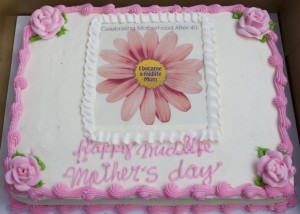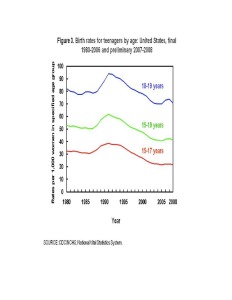Today’s CNN Health site features a story called “How scary is having a baby when you’re over 40?” in which I’m cited in relation to the wage effect of delay. (The story is linked to the news of the rise in births to women 40+ in the 2008 CDC birth data.)
The CNN reporter got the drift of my findings (i.e., that delay is linked to higher salaries; Ready, 2007), but the particulars were missing some context, so I’ll fill that in (in boldface) here.
My analysis of Census 2000 data, correlating salary to a mother’s age at first birth, indicates that, when you compare women who have the same university degrees, a mother’s age at first birth links to long-term salary differences.
The biggest salary gains were for women who had invested some of the delay time in getting an advanced degree and then went on to establish at work before having kids.
Among full-time working mothers who were 40-45 in 2000 with professional degrees, those who had had children in their mid-twenties averaged salaries in the mid $40K range, while those who were the same age and had the same degree but had their kids in their mid to late 30s averaged in the mid $70Ks. Among full-time working women with BA’s who were 40-45 in 2000, those who had their first kids in their mid-twenties were earning in the mid $30K range and those who waited til their mid-thirties were making the mid $40K range, in 2000.
The reasons are straightforward — women who delay kids are likely to have gotten their degrees earlier, to have begun their professional careers earlier and to have climbed higher at work before kids arrive.
Once kids arrive, it’s much harder for women to continue to climb, so if they start earlier, they tend to get stuck lower down on the ladder. And women who are higher up the ladder have an easier time negotiating a flexible schedule that will allow them to stay in the workforce while raising kids, so they don’t experience the same salary losses that moms who step out and then try to step back in often do.
Because our work system has offered few reliable options for balancing job and life for young women starting out, many women have used delay as a form of shadow benefits system—taking the well-being of their families into their own hands when they can’t rely on employers or the government to look out for them.
My findings have been echoed in other studies. For instance, in the past it’s been understood that, overall, women who had kids made less than women who had none (the “motherhood penalty”). But a study out last week by Joan Kahn indicates that women who had kids after 26 did not suffer a “motherhood penalty” because they tend to have gotten more education and job training.
Another study (Buckles 2008) that looked at women delaying kids (with data through first birth at 36) found that there was a 3% annual return to delay – meaning that women’s average long-term salary rose 3% for every year they delayed.
For more details see Ready: Why Women Are Embracing the New Later Motherhood (Basic Books, 2007), pp. 55-63, 281.


 Equal Pay Day (April 20, 2010) reminds us that the average US woman would have to work this far into 2010 in addition to what she worked in 2009 to make the same wage that the average US man made in 2009 alone. There are lots of parts to this wage inequality — part-time vs full-time work / discrimination within the same job / channeling of women into lower paid industries, etc — but for women they add up to an undue big-picture disparity, higher rates of poverty, lower status and diminished influence on policy.
Equal Pay Day (April 20, 2010) reminds us that the average US woman would have to work this far into 2010 in addition to what she worked in 2009 to make the same wage that the average US man made in 2009 alone. There are lots of parts to this wage inequality — part-time vs full-time work / discrimination within the same job / channeling of women into lower paid industries, etc — but for women they add up to an undue big-picture disparity, higher rates of poverty, lower status and diminished influence on policy. 
 Blue line 18-19, Green = 15-19, Red = 15-17.
Blue line 18-19, Green = 15-19, Red = 15-17.